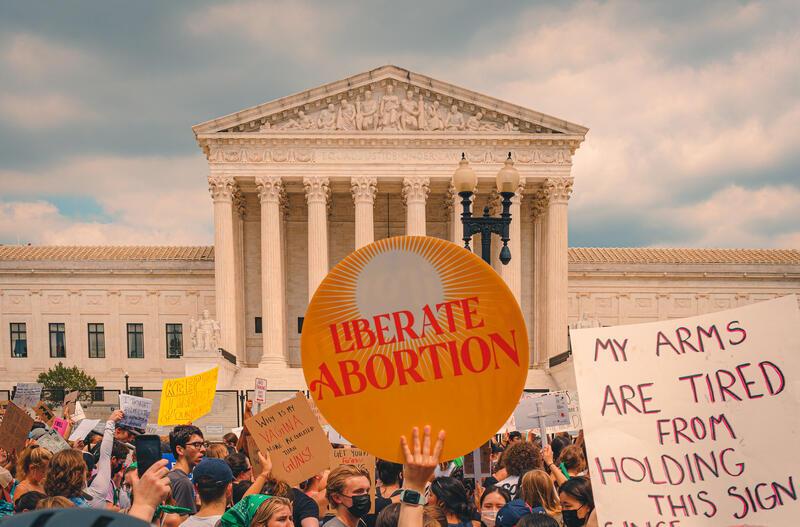The Limits of Framing Abortion Rights as a Religious Issue
On June 24, the Supreme Court released its decision in Dobbs v. Jackson Women’s Health Organization. In a 6-3 ruling, the court overturned Roe v. Wade, which stated that women had a constitutional right to abortion.
The ramifications were immediate. Due to existing “trigger bans,” designed to go into effect the instant Roe was overturned, abortion will now be functionally illegal in thirteen states. An additional seven states are likely to pass laws against abortion in the next several months, and another twelve face possible abortion bans as well.
Abortion rights advocates have noted that this ruling is part of a right-wing movement that has actively sought to place anti-abortion judges on the Supreme Court, with the ultimate goal of repealing rulings that have supported reproductive freedoms, gay rights, and trans rights. Terrifyingly, they have succeeded so far.
There is an instinctive tendency to frame anti-abortion laws as “medieval,” suggesting that the overturning of Roe v. Wade is regressive, or is pushing us back into a more restrictive time period. In fact, the opposite is true: Abortion bans as early as six weeks, with no exceptions for incest, rape, or medical complications, do not have a medieval precedent. Rather, these bans are a modern phenomenon of our politically divided climate.
The right to abortion, well documented in Jewish sources, goes back as far as the Talmud. For this reason, some Jews have framed the new abortion restrcitions as an infringement upon their religious freedom. As people like Rabbi Danya Ruttenberg and Sheila Katz have pointed out, halacha, or Jewish law, demands access to abortion if continuing the pregnancy poses a danger to the person carrying the fetus. In this sense, a lack of access to abortion at any stage in a pregnancy violates Jews’ right to practice their religion.
However, halacha is not absolute. Rabbis continue to disagree about when abortion can and should be allowed. It’s not entirely accurate, then, to characterize Judaism as inherently pro-abortion rights. Still, the violation of religious freedoms can be an effective way to push back against the evangelical Christian hegemony that currently dominates our legal system. For example, following the institution of a fifteen-week abortion ban in Florida, and the leaked Supreme Court draft opinion, a synagogue called Congregation L’Dor Va-Dor sued the state of Florida on the grounds that the ban violates Jews’ religious freedom.
Relying solely on the religious freedom argument does not protect the secular right to abortion, but considering how evangelical Christians often argue allowing abortion violates their religious freedom, asserting the validity of other religious perspectives, such as those of Jews and Muslims, is both important and useful.
Even in Christianity, views on abortion haven’t always been clear: early Christian authorities were split on the issue of abortion in Late Antiquity (from the first to the fifth centuries). A few Christian theologians decreed that a fetus had a soul upon conception, and abortion at any stage was therefore murder. However, following the thinking of St. Augustine, medieval Christians generally thought that the fetus was “ensouled” after 40 days, and before that, abortion was neither murder nor a sin.
Without modern technology, determining when “ensoulment” occurred was subjective and usually determined in relation to quickening (when the fetus first moves), which occurs at some point between 16 and 20 weeks. Until the fetus quickened, abortion was not punishable. Early Muslim theologians similarly argued that abortion was allowed before ensoulment—depending on the sect and authority, this happened at 40, 90, or 120 days.
In the Middle Ages, Jewish authorities did not consider abortion murder, but did consider it a grave offense, unless, as noted above, the fetus posed a danger to the mother, or it occured before 40 days. Unlike Christians, medieval rabbis, such as Rashi, thought that a fetus could not have the status of a nefesh (a soul). More stringent positions, following the work of Maimonides, thought a fetus did have the status of a nefesh, but that the life of the mother should still take precedence.
Importantly, having children was, and for many Jews still is, a highly valued mitzvah, so while we have religious and historical precedents in Judaism for abortion rights, we cannot dismiss the fact that rabbis have ruled—and continue to rule—that abortion only be allowed under certain circumstances.
It’s also worth noting that the theological rulings from the pre-modern period in all three major religions come almost entirely from male authorities. Medieval medical manuals offer a small window into women’s lived experiences. While most medical treatises were recorded by men in Latin, Hebrew, or Arabic (the Trotula, a twelfth-century text from a woman in Salerno is the exception), the manuscripts often note that the information largely comes from the practices of women.
The historian Monica Green has found that female physicians in the Middle Ages not only provided gynecological care to other women, but also general medical care to all people. Women transmitted knowledge of herbs and medical practices orally, across religious divides, and there is evidence that childbirth was often a space where Muslim, Christian, and Jewish women interacted, as midwives and as neighbors.
Medical treatises from medieval Europe and Northern Africa contain recipes for both abortion and contraception (also permitted within halacha). For example, a Judeo-Arabic text, Sefer Dinah, includes a recipe: “To abort the foetus. She should take one dirhem opoponax and she will abort quickly. Or let the woman eat green peppermint for seven days on an empty stomach and she will never conceive.”
These practices occurred among Christians in the Middle Ages, too. The German nun Hildegard of Bingen writes about wild ginger: “A pregnant woman will eat it, either on account she languishes or she aborts an infant which is a danger to her body, or if she has not had a menstrual period for a time period so that it hurts.” This recipe points to a trend in medieval Christian theology that, like in Judaism and Islam, allowed for abortion when the pregnancy posed a danger to the mother. Other medical texts describe how to surgically remove a fetus that has either already died, or is causing an immediate danger to the person giving birth.
From these medical texts, we can assume that women relied on each other and their own medical knowledge for abortion and contraceptives. These practices, while condemned at times by certain religious sects, seem rarely to have been questioned on a practical level.
In the fifteenth and sixteenth centuries, the growing centralization of secular legal practices and increased use of prisons in Europe allowed for more scrutiny of women’s medical practices. Trials from late medieval Germany indicate an increasingly hostile attitude to abortion. During the same time period, the witch craze began, whereby religious authorities targeted people who engaged in herbal lore or what they considered “pagan” practices. .
The witch trials were also connected to a growing reluctance, beginning as early as the thirteenth century, to trust female physicians and midwives over men who were university- trained. A growing reliance on science-based medicine in the sixteenth to eighteenth centuries allowed men to gain control over women’s medicine, pushing women to the margins of medical practice.
As modern medicine continued to progress, colonialism and eugenics shaped gynecology into a deeply racialized field: J. Marion Sims, the so-called “father of gynecology,” earned his title in the early nineteenth century, when he performed painful medical experiments on Black women, without providing anesthesia. About 30 years later, in 1847, the formation of the American Medical Association brought about a formal institution of white male doctors who sought to control female bodies. At the urging of the AMA, states began to impose unprecedented abortion bans, which would not be overturned until Roe.
Throughout the first half of the twentieth century, women from different religions and backgrounds joined the fight for reproductive justice, even as state laws made abortion less safe and less accessible. In the 1960s, just before Roe became law,, most states had bans on abortion. Women continued to rely on one another to gain access to reproductive care, defying religious boundaries. From 1969 to1973, for example, Jane, a collective founded by a Jewish woman and with many Jewish members, provided access to women of all religious backgrounds.
While abortion rights have been more secure in the past 50 years, thanks to Roe, advocates for reproductive justice have continued the work that feminists began in the twentieth century. Much of the recent work of the abortion rights movement has focused on protecting existing abortion practices and making medical procedures more accessible and safe for anyone who might need them. Women of color have led this fight for reproductive justice, addressing the ways our modern political and medical institutions make abortion, pregnancy, and childbirth inaccessible and unsafe for non-white people.
Today, Judaism and Islam seem to offer less restrictive perspectives on abortion than Christianity. However, Judaism still does not guarantee women the right to govern their own bodies. Women who are more religiously observant are still expected to get permission from a rabbi before having an abortion, and in Israel, which is governed by Jewish law, a person can only have an abortion if a termination committee decides that certain criteria are met. While the majority of cases are approved, the system still curbs women’s bodily autonomy and limits a person’s right to choose.
As much as our Jewish faith offers support for abortion rights, framing the fight for bodily autonomy as a religious issue has limits. Jewish people who are marginalized, such as people of color, face obstacles to accessing abortion similar to those faced by marginalized people of other faiths, including Christianity. Access to safe abortions is a right that should be guaranteed to all people, and no religion has the right to infringe on that secular freedom. It is essential that we unite across religious boundaries in the fight for bodily autonomy for all.







